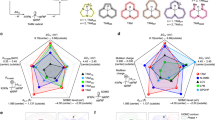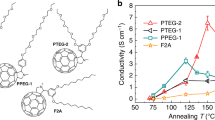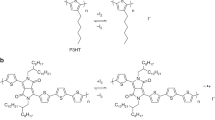Abstract
Significant improvements to the thermoelectric figure of merit ZT have emerged in recent years, primarily due to the engineering of material composition and nanostructure in inorganic semiconductors1 (ISCs). However, many present high-ZT materials are based on low-abundance elements that pose challenges for scale-up, as they entail high material costs in addition to brittleness and difficulty in large-area deposition. Here we demonstrate a strategy to improve ZT in conductive polymers and other organic semiconductors (OSCs) for which the base elements are earth-abundant. By minimizing total dopant volume, we show that all three parameters constituting ZT vary in a manner so that ZT increases; this stands in sharp contrast to ISCs, for which these parameters have trade-offs. Reducing dopant volume is found to be as important as optimizing carrier concentration when maximizing ZT in OSCs. Implementing this strategy with the dopant poly(styrenesulphonate) in poly(3,4-ethylenedioxythiophene), we achieve Z T = 0.42 at room temperature.
This is a preview of subscription content, access via your institution
Access options
Subscribe to this journal
Receive 12 print issues and online access
$259.00 per year
only $21.58 per issue
Buy this article
- Purchase on Springer Link
- Instant access to full article PDF
Prices may be subject to local taxes which are calculated during checkout



Similar content being viewed by others
References
Bell, L. E. Cooling, heating, generating power, and recovering waste heat with thermoelectric systems. Science 321, 1457–1461 (2008).
Bubnova, O. et al. Optimization of the thermoelectric figure of merit in the conducting polymer poly(3,4-ethylenedioxythiophene). Nature Mater. 10, 429–433 (2011).
Gregg, B. A., Chen, S. & Cormier, R. A. Coulomb forces and doping in organic semiconductors. Chem. Mater. 16, 4586–4599 (2004).
Kim, G-H. & Pipe, K. P. Thermoelectric model to characterize carrier transport in organic semiconductors. Phys. Rev. B 86, 085208 (2012).
Kim, Y. et al. Highly conductive PEDOT:PSS electrodes with optimized solvent and thermal post-treatment for ITO-free organic solar cells. Adv. Funct. Mater. 21, 1076–1081 (2011).
Xia, Y., Sun, K. & Ouyang, J. Solution-processed metallic conducting polymer films as transparent electrode of optoelectronic devices. Adv. Mater. 24, 2436–2440 (2012).
Kirchmeyer, S., Elschner, A., Reuter, K., Lövenich, W. & Merker, U. PEDOT: Principles and Applications of an Intrinsically Conductive Polymer (Taylor Francis, 2011).
Liu, C. et al. Highly conducting free-standing poly(3,4-ethylenedioxythiophene)/poly(styrenesulfonate) films with improved thermoelectric performances. Synth. Met. 160, 2481–2485 (2010).
Zhang, B., Sun, J., Katz, H. E., Fang, F. & Opila, R. L. Promising thermoelectric properties of commercial PEDOT:PSS materials and their Bi2Te3 powder composites. Appl. Mater. Interfaces 2, 3170–3178 (2010).
Yue, R. & Xu, J. Poly(3,4-ethylenedioxythiophene) as promising organic thermoelectric materials: A mini-review. Synth. Met. 162, 912–917 (2012).
Lang, U., Müller, E., Naujoks, N. & Dual, J. Microscopical investigations of PEDOT:PSS thin films. Adv. Funct. Mater. 19, 1215–1220 (2009).
Nardes, A. M. et al. Microscopic understanding of the anisotropic conductivity of PEDOT:PSS thin films. Adv. Mater. 19, 1196–1200 (2007).
Borsenberger, P. M., Pautmeier, L. & Bässler, H. Hole transport in bis(4-N,N-diethylamino-2-methylphenyl)-4-methyl phenyl methane. J. Chem. Phys. 95, 1258–1265 (1991).
Kahol, P. K., Satheesh Kumar, K. K., Geetha, S. & Trivedi, D. C. Effect of dopants on electron localization length in polyaniline. Synth. Met. 139, 191–200 (2003).
Koh, Y. K. et al. Comparison of the 3ω method and time-domain thermoreflectance for measurements of the cross-plane thermal conductivity of epitaxial semiconductors. J. Appl. Phys. 105, 054303 (2009).
Ju, Y. S., Kurabayashi, K. & Goodson, K. E. Thermal characterization of anisotropic thin dielectric films using harmonic Joule heating. Thin Solid Films 339, 160–164 (1999).
Acknowledgements
The authors thank J. Kim and K. Chung for assistance and discussions regarding sample preparation. This work was supported as part of the Center for Solar and Thermal Energy Conversion, an Energy Frontier Research Center funded by the US Department of Energy, Office of Science, Basic Energy Sciences under Award No. DE-SC0000957.
Author information
Authors and Affiliations
Contributions
G-H.K. developed the ideas for this work, prepared the polymer films, and performed measurements of Seebeck coefficient and electrical conductivity. L.S. performed Al2O3 and gold depositions and and gold depositions as well as sample thickness and XPS measurements. K.Z. performed thermal conductivity measurements. K.P.P. supervised the project. G-H.K. and K.P.P. prepared the manuscript, and all authors participated in editing.
Corresponding author
Ethics declarations
Competing interests
The authors declare no competing financial interests.
Supplementary information
Supplementary Information
Supplementary Information (PDF 834 kb)
Rights and permissions
About this article
Cite this article
Kim, GH., Shao, L., Zhang, K. et al. Engineered doping of organic semiconductors for enhanced thermoelectric efficiency. Nature Mater 12, 719–723 (2013). https://doi.org/10.1038/nmat3635
Received:
Accepted:
Published:
Issue Date:
DOI: https://doi.org/10.1038/nmat3635
This article is cited by
-
Additive manufacturing of thermoelectric materials: materials, synthesis and manufacturing: a review
Journal of Materials Science (2024)
-
Electrical properties of polyaniline (PANI)-porous silicon (PS) heterostructure
Polymer Bulletin (2024)
-
Solvation Engineering via Fluorosurfactant Additive Toward Boosted Lithium-Ion Thermoelectrochemical Cells
Nano-Micro Letters (2024)
-
Effect of Molecular Weight on Thermoelectric Performance of P3HT Analogues with 2-Propoxyethyl Side Chains
Journal of Wuhan University of Technology-Mater. Sci. Ed. (2024)
-
Acceptor-acceptor type polymers based on cyano-substituted benzochalcogenadiazole and diketopyrrolopyrrole for high-efficiency n-type organic thermoelectrics
Polymer Journal (2023)



